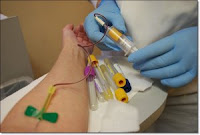It started with falling. A lot. Falling down the back porch stairs. In grocery stores, coffee shops. One bad fall just before a concert in which I had a solo. Usually I'd land on my knees (which contributed to a very painful torn meniscus and surgery to repair it last summer) and occasionally on my bum (which once contributed to a very colorful hip and cheek - no photo included here). The falls were due to a combination of loss of balance from
peripheral neuropathy and from foot drop. My toes would catch on the slightest bump and over I'd go, with no good recovery mechanism because of the balance issue.
I'm using the past tense here, not because the problems have gone away, but because I have some tools at my disposal and because I've become so mindful of my movements and out of necessity, walk very slowly (which usually isn't a bad thing at all). It’s been more than a year since I’ve fallen. I've had some close calls, but with physical supports and mindfulness, I’ve managed to avoid that most unpleasant feeling of taking a tumble without a net.
I started with a cane. Looking back, that was probably the most difficult decision to make, as it signified the first real acknowledgement of disability. At first I used it only when I was out and about. It offers me stability and, as a wise person pointed out to me, it’s a signal to others that I have a physical challenge that isn’t immediately obvious. It was becoming difficult to be in crowds – I get panicky when I feel trapped or when I’m being jostled and the risk of falling greatly increases. Soon I was using the cane most of the time, even in the house.

Two years ago I was in the hospital for a surgery (which I may or may not discuss later). Apparently it became obvious to at least one nurse and by extension, my doctor, that a walker would be a good choice for me. A couple weeks later, the home health van pulled up and delivered one to me, which I was completely unaware of and unprepared for, emotionally. The walker sat for a week or two, me staring at it, feeling resentful and unwilling to take
that step (so to speak). But when Laurie and I went for a walk and I was able to go farther than I had for months – maybe even years – I had a change of heart. I embraced it, decorated it (sock monkeys rule!) and began to have fun with it. What I love about these walkers is the built in seat – if I get fatigued or sore, I can turn around and voila! A chair! Waiting in line at the post office? No problem. At a party with limited seating? Thanks, I brought my own.
 |
| Ms. P and I "stroll" around the block |
But the thing about a walker is, well, you still have to walk. And that’s become increasingly difficult and painful for me. I was having to drive everywhere, even just a few blocks to the grocery store or the library. So when Laurie’s brother and sister-in-law told us their friend was selling an electric scooter for a very good price, I decided to give it a whirl. Wow. Talk about getting my life back! Now I can zip all around the neighborhood, take Liza for long walks at her pace, go to the grocery store, the bank, the library and just MEANDER! I haven’t meandered for years! I feel like I’ve reclaimed my neighborhood. I’m taking photos again (
my photo blog), now from the seat of the scooter – I call it “scootography.”
The point I'm trying to make in this long winded post is how difficult it is to accept disability - and nothing screams disability like canes, walkers and scooters - but once the hurdle is cleared, the tools available to us can improve the quality of life enormously. I could easily become a shut-in. But there's a lot of living to do out there in the world, and I'm so grateful for the tools available to help me do that. And to the people who've encouraged me to take advantage of them and who help make that happen.
Next up: the biggest, fattest tool of all. We get a stair lift installed tomorrow!
~~~~~~~~~~~~~~~~~~~~~~~~~~



